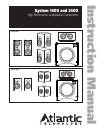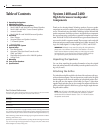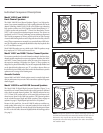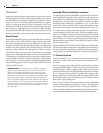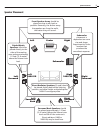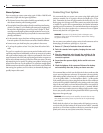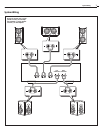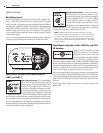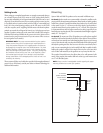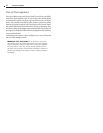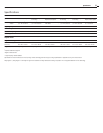
8
System 1400 and 2400 High Performance Loudspeakers
Boundary Compensation
Use this switch to adjust
the lower frequency output of the speaker to com-
pensate for the typical sound colorations caused by
placing the speaker close to a TV screen or building
it into a wall unit or cabinet. To set these controls, sit
in the prime listening position and have someone
switch between the compensation choices, using well
recorded dialogue or musical instrument recordings. Choose whichever
switch position sounds most natural and real to you.
NOTE:
Although these controls have been designed to compen-
sate for various acoustic room anomalies, we recommend that you
try them to hear the difference that they make in the sound of the
system. For any number of reasons, you may decide that you prefer
them set in a particular manner that sounds best to you. Experiment.
It will be worth it.
Dipole/Bipole Operation of the 1400 SR-z and 2400
SR Speakers
In Dipole mode the 1400 SR-z and 2400
SR’s produce ambience with minimal
localization (best for most movies and
video soundtracks), and more localizable
sound in the Bipole mode (preferred for some music recordings). Switch-
ing between Dipole and Bipole mode is easily accomplished using a toggle
switch conveniently located in the speakers rear terminal cup. Please note
that the vast majority of the time in movies and TV broadcasts the surround
speakers are called upon to reproduce the environmental sounds that are
used as cues to help get you immersed in the scene on the screen.
Once the surround speakers are properly positioned in the listening area,
we recommend that you begin with the dipole mode, as this usually deliv-
ers the most involving and believable surround performance in most situ-
ations. However, as noted above, feel free to experiment with both switch
positions.
When using as front "height" speakers, we recommend starting in the
Bipole mode.
System Setup
System Setup
Bass Management
Some older surround sound decoders and receivers offer a choice of “Nor-
mal” or “Wide-band” modes for the center channel speaker. The Model
1400 C and 2400 C are designed to be used in the Normal mode. Addition-
ally, digital processing multi-channel systems provide a Bass Management
menu, which typically requires you to select between “Small” or “Large”
speakers during system set-up. Since these systems have been designed
to work with a dedicated subwoofer, please set all the speakers in System
1400 or 2400 to Small.
If your receiver or processor has selectable subwoofer crossover frequencies,
we suggest using 80-100Hz for the 2400 and 100-120Hz for the 1400.
Operation of the Rear Panel Controls on the
1400 C and 2400 C
High Frequency Energy
This control changes
the tilt or roll-off slope of the tweeter. It has been
designed to help compensate for different room
acoustics. The Average position is intended for
rooms with a reasonable combination of reflec-
tive (hard) and absorptive (soft) surfaces. The
Reverberant position is designed for rooms with
an abundance of reflective surfaces like hardwood or tile floors, glass walls,
etc. It decreases the high frequency output of the speaker to reduce excess
HF energy that builds up in live rooms. The Damped position brings the
tweeter’s output slightly above flat response to compensate for overly absor-
bent rooms with lots of soft surfaces. Speakers in overly damped rooms can
sound dead and lifeless unless compensated.
Figure 4



